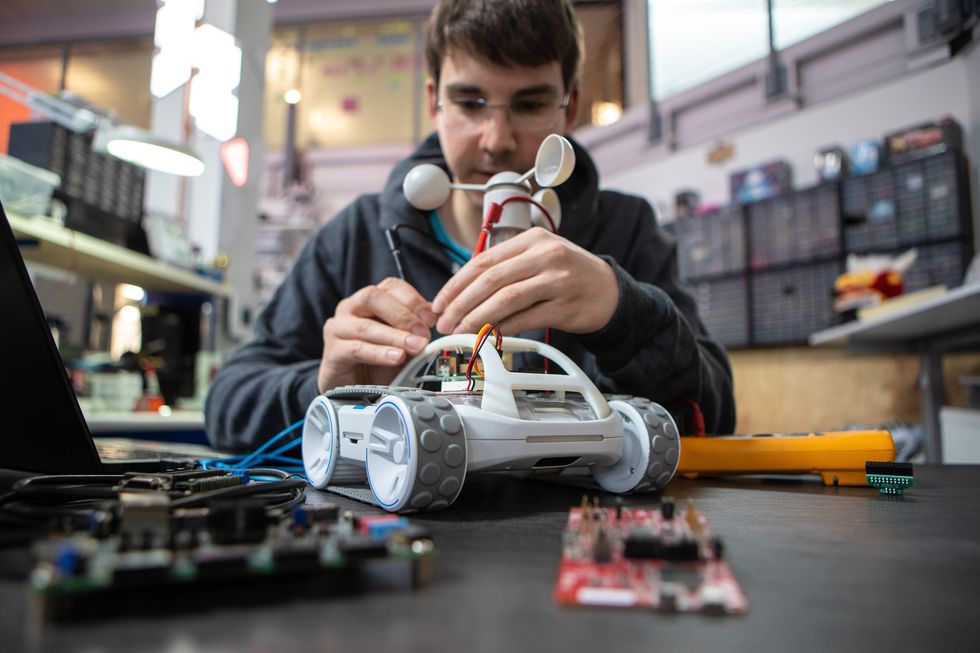Sphero is introducing a new robot today on Kickstarter. Called RVR, which can either be pronounced just like it’s spelled or like “rover,” the robot is a development platform designed to be a bridge between educational robots like Sphero and more sophisticated and expensive platforms like Misty. It’s mostly affordable, very expandable, and comes from a company with a lot of experience making robots.
For a US $199 Kickstarter pledge, this looks like a very solid little robot, carefully thought-out and designed to be rugged and durable. It comes with an ambient light sensor, RGB color sensor, 9-axis IMU, IR sensors, magnetic encoders for the wheels, and a bunch of LEDs. The obvious thing that RVR is missing is a camera, but that’s probably because it’s designed to be hardware expandable, with integrated power and data ports that make it easy to add a Raspberry Pi or Arduino or other sensors or hardware.
As Sphero points out, designing and building a robot like RVR for yourself is likely to be more expensive than just buying one, and that’s even counting the time and effort and skill that you’d need to do so. If you’re more interested in software and hardware anyway, that makes RVR an easy choice. Sphero already has a coding ecosystem in place that can grow with your skills, starting with a graphical interface and then moving on to a Blockly-looking interface that gives you more options while still handling much of the tricky bits. Beyond that, you can move on to coding with raw, painful text.

One particularly interesting feature that RVR comes with is the ability to talk with other Sphero robots via infrared:
Adding an IR sensor to RVR opens up a whole new world of possibilities. Onboard infrared sensors provide 360-degree sensing and allow for bot-to-bot communication, robot follow and robot evade. Imagine a troop of BOLTs chasing a RVR through an obstacle course, a covert ops capture the flag game, robot laser tag, or swarm programming with choreography and lights.
This sounds very cool, but it brings up an important issue with “platforms” like RVR: While they can potentially do a great many things, out of the box they usually do only the most basic.
Want RVR to be your home security sentry? A roving environmental sensor you can control over the internet? How about a souped-up battle bot? An autonomous metal detector or perhaps a personalized mobile voice assistant?
Can it do all of these things? Sure, if you program it to, but doing so is likely non-trivial. As Sphero says, “chances are, if you can hack it, RVR can do it,” just keep in mind that “hacking it” may require a lot of work. This problem is not unique to RVR—all robotic development platforms have the same issue. And as long as you understand exactly what you’re getting, that’s totally fine. If you want a fun robotic toy, though, RVR may not be right for you, and I’d only suggest getting one if you’re someone who either enjoys or wants to learn coding and also wants to put a substantial amount of work into RVR once it arrives.
Also, we’re obligated to remind you that you’re pledging for a Kickstarter here, not buying a product. We have no reason to think that Sphero won’t be able to deliver on RVR, and by getting in on the Kickstarter you can save some money. But it would also be completely reasonable to wait until the fall and see how RVR looks once people start receiving them and messing around with them—and what expansion kits SparkFun, which is partnering with Sphero, has created—and then make a decision about whether you want one.
Sphero RVR is on Kickstarter now for $199, with delivery in October of 2019.
[ Sphero ]
Evan Ackerman is a senior editor at IEEE Spectrum. Since 2007, he has written over 6,000 articles on robotics and technology. He has a degree in Martian geology and is excellent at playing bagpipes.




